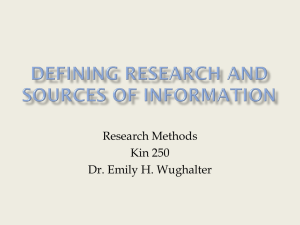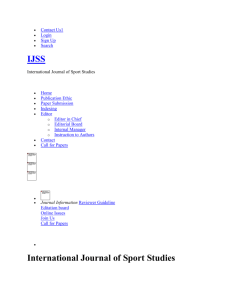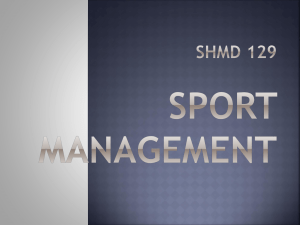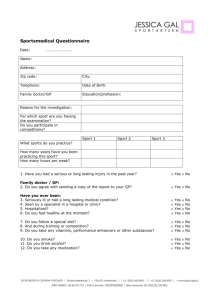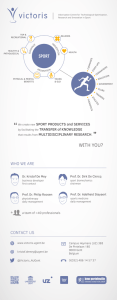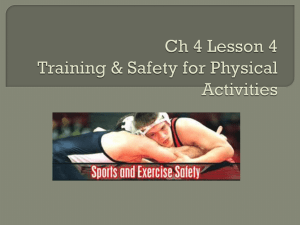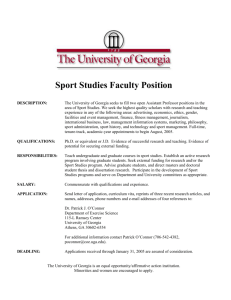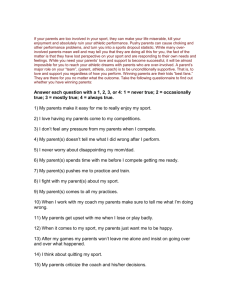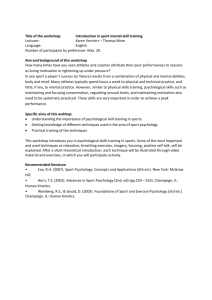PE - National Curriculum
advertisement
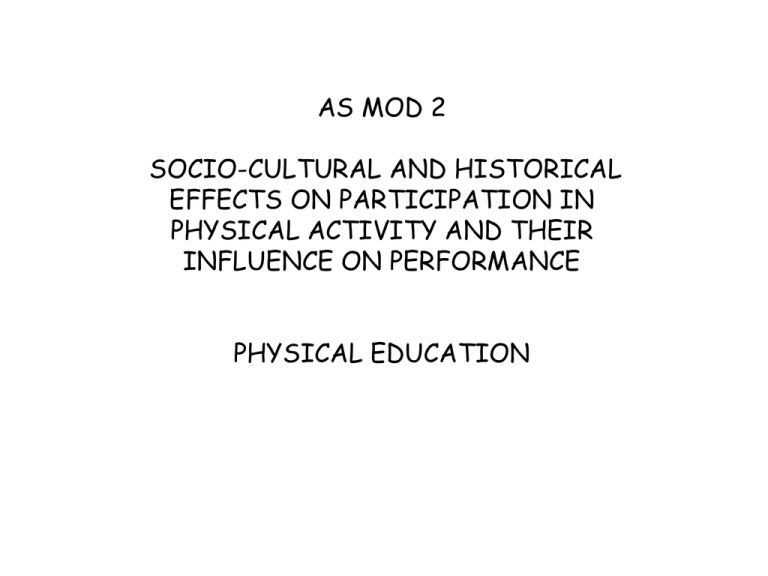
AS MOD 2 SOCIO-CULTURAL AND HISTORICAL EFFECTS ON PARTICIPATION IN PHYSICAL ACTIVITY AND THEIR INFLUENCE ON PERFORMANCE PHYSICAL EDUCATION TOPIC OBJECTIVES PHYSICAL EDUCATION -Its objectives in terms of (a) the EDUCATIONAL PROCESS - physically - socially - intellectually (b) the INDIVIDUAL - physically - socially - intellectually - A consideration of its (a) CULTURAL VALUES (b) EDUCATIONAL VALUES (c) SOCIAL VALUES P.E and the Educational Process Groups: i.) What is the National Curriculum? - Est end of 1980’s - Semi-centralized approach towards Education - Allows Govt: more control over Education more teacher accountability national Standards set for Education a wider range of activities to be taught - All state schools follow SET guidelines about SET subjects to teach - The Schools and their guidelines are inspected by OFSTED ii.) What is Physical Education? An educational process which aims to enhance total human development and performance through movement and the experience of a range of physical activities within an educational setting iii.) What are the key aims of Physical Education? - achieve physical competence and confidence perform in a range of activities achieve physical skillfulness gain knowledge of the body in action become a CRITICAL PERFORMER learn competitiveness, creativity; face up to challenges learn how to Plan, Perform and Evaluate discover their abilities, aptitudes and make choices for lifelong learning Key concepts of the National Curriculum Therapeutic Functions - Raises awareness in children of need for a HEALTHY lifestyle Sedentary lifestyles; active play v computer/tv generation Child safety concerns FAST FOOD culture Creativity - Help children become more creative and imaginative in their PE lessons Recreational Breadth - Range of activities in PE has increased - Facilities - Abilities of teachers have increased - The more activities you experience, the more likely that you are to find one you enjoy and carry on into later life Critical Performer - Provide knowledge of other roles in sport to appreciate physical activities in different ways - e.g Officiating, spectating, coaching, leadership roles etc Range of Activities Why? Provide balanced physical development Classifications? Games Athletic activities Swimming Gymnastics Dance Outdoor and Adventurous Activities Forseeable problems? Schools not being able to offer every sport Team v Individual Comp v Non comp Categories of Sports INVASION NET/WALL STRIKING/ FIELDING TARGET MOVEMENT Football Tennis Cricket Golf Gymnastics Netball Badminton Rounders bowls Dance Basketball Table tennis softball Hockey volleyball rugby Trampolining Athletics swimming Structure of the National Curriculum 4 Key Stages Group work using text books (Group 1) Identify Key Stages 1 and 2 Outline physical activity experience available to these key stages (Group 2) Identify Key Stages 3 and 4 What are the general requirements for each KS of NC YOU MUST PRESENT BACK USING PICTURES, AND WHERE APPROPRIATE, NUMBERS ONLY!! Assessment in P.E - Each KS has an end of KS DESCRIPTION and 8 LEVELS of ATTAINMENT - Teachers record PPE in pupil’s reports - Teacher indicates whether pupil is working BEYOND AT THE LEVEL TOWARDS end of KS Descriptors Question.) What is the purpose of Attainment Targets To set GENERAL EXPECTATIONS of what pupils should be able to accomplish by end of each Stage Question.) Give ADVANTAGES and DISADVANTAGES of assessment ADVANTAGES DISADVANTAGES Clear objectives and goals to reach Too much time on testing and not participating Gives incentives/rewards and motivation to improve Tests are mainly subjective Improves quality of teaching Not every child can achieve the highest levels Gives recognition to good teachers Can demotivate teachers and children due to unfair comparisons Too much pressure-takes away the fun element LEVEL 1.) Pupils – Copy, repeat and explore simple skills and actions with basic control and co-ordination - Start to link these skills and actions in ways that suit the activities - Describe and comment on their own and others actions - Talk about how to exercise safely and how their bodies feel during activity Question.) In groups design Levels 4 and 8? Extra Curricular Question.) What does this mean? - Optional “activities” offered in schools during lunchtimes and after school - Offer purely recreational experiences as well as SCHOOL SPORT (competitive fixtures) Question.) How do SCHOOL SPORT and PE differ? PE SCHOOL SPORT Compulsory Non compulsory Provides building blocks for many sports Enhance and extend interest and aptitiude in a sport


